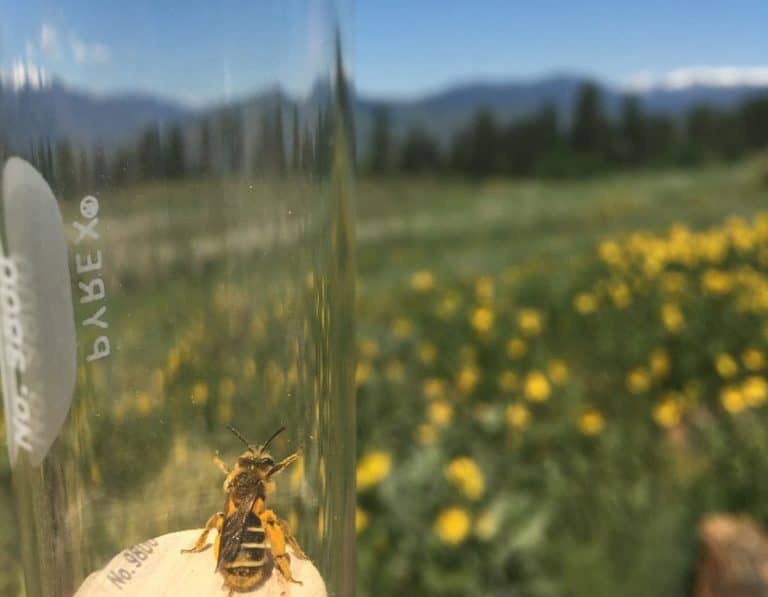
Plight of the Pollinators
Imagine yourself walking down to the local summer farmer’s market down by the town square. It’s the first warm day and you cannot wait to make a large juicy bowl of fruit salad for lunch. Summer time in the valley is your favorite, all winter you have eagerly anticipated the first fruits of the season. With your list in hand that you scribbled down this morning, juicy red tomatoes, green zucchini, bright yellow summer squash, perfectly round peaches, you set off.
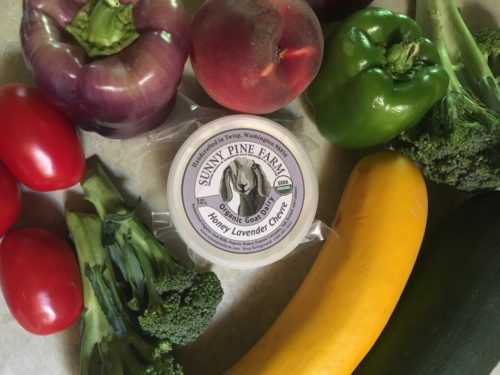
Produce from the local Twisp Farmers Market. Photo courtesy of Kay Gallagher
After a short walk, you arrive at the farmers’ market, ready to fill your basket to the brim. You walk around and notice the usual vendors. The local bakery selling loaves of freshly made artisan bread, the various craftsmen selling their woolen blankets and knit scarves, the goat farmers selling their savory cheeses and assorted dairy products. Then you notice there are no fruit stands. No vegetable stands. There isn’t so much as a rogue berry in sight. Where are the fruits of summer you have been dreaming about since that first warm day of spring? It’s almost as if they have vanished overnight. They’re not there.
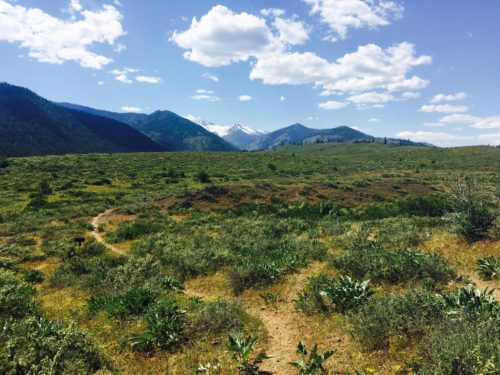
The colorful mosaic landscape of Patterson Mountain. Photo courtesy of Kay Gallagher
You leave the farmer’s market quite perplexed, and decide to hike your favorite summer trail instead. On your drive to the trailhead you can picture the lush mountain sides and vast fields full of a colorful array of wildflowers from last summer, you can visualize the river coursing its way through the landscape in the valley below, with animal life whirring and scattered about. You arrive at the trailhead, and hop out of the car, eager for your adventure in the colorful mosaic. As you begin to hike, you notice that things aren’t as colorful as they used to be. There aren’t nearly as many wildflowers, the earth seems dry and crumbly with serious signs of erosion along the river bank below. The landscape is made up of various shades of brown. The air is noticeably quieter, without the hums and whizzing of winged insects flying about. The chatter of birds is absent, and the silence seems a little eerie. It’s a little too quiet. Something is missing, and then you realize …” Where have all the pollinators gone?”
This scene isn’t just a nightmare of the imagination, it’s a potential reality for the world we live in. The effects of the absence of pollinators are not just limited to human beings that rely heavily on them for economic reasons and sustenance. The very ground we stand on, our ecosystem, our home, heavily depends on pollinators for the myriad of irreplaceable ecological services they provide.
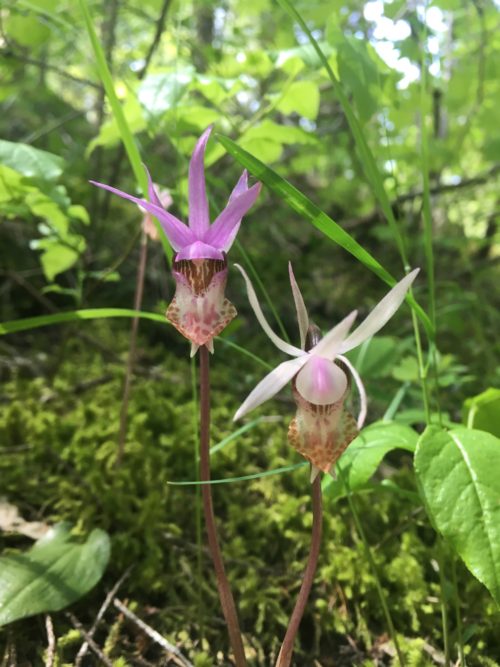
Plants like these Calypso Orchids, rely on the presence of pollinators. Photo courtesy of Kay Gallagher
In fact, a staggering eighty five percent of all land based plants on earth require or benefit from the presence of a pollinator, and most of those pollinators are insects. Whether it’s pollinating crops, irrigating soils, aiding in decomposition, pollinating trees that provide the clean air to breathe, aiding in producing leaves that provide shelter or habitat, or serving as a food resource for other organisms, we depend on pollinators for our very existence and survival.
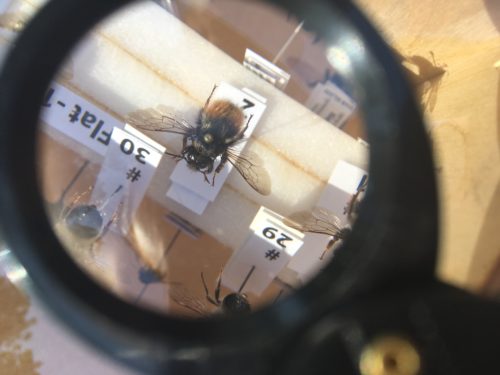
Did you know that there are over 600 species of native bees in Washington State alone? Here is one of them up close. Photo courtesy of Kay Gallagher
Aside from providing agricultural services for human economy and sustenance, pollinators offer many irreplaceable benefits to ecosystems. For example, tunnels of ground-nesting pollinators such as solitary bees help improve soil texture. This irrigation of soil, aids in water movement to the roots of plants and better incorporates nutrients into the soil. These contributions directly translate into healthier plant communities whose roots systems help bind the soil thus preventing erosion and keeping waterways clean for aquatic life.
Much like ourselves, many other animals depend on pollinators to aid in providing fruits and seeds as part of their diets.
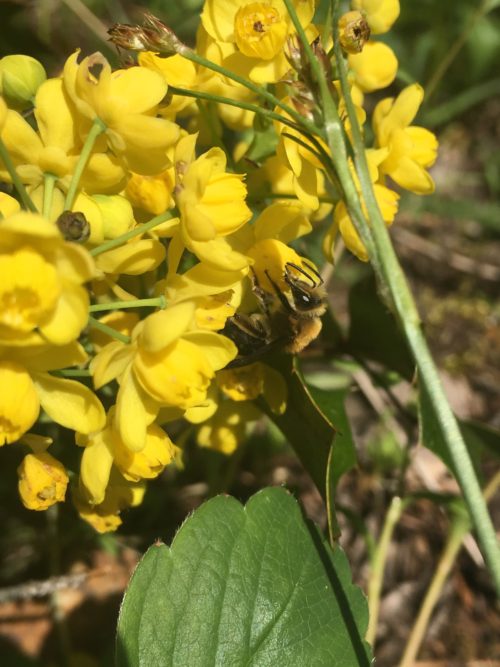
A bee pollinates an Oregon Grape plant, which many other animals rely on its berries and leaves as a food source. Photo courtesy of Kay Gallagher
Bumblebees are largely responsible for pollinating many wild fruits and berries, that black bears and pikas, rely on to sustain themselves over the long winter season and through the rest of the year. Lastly, pollinators themselves serve as food sources for other organisms higher up in the larger food chain. Insects provide forage and protein for a wide variety of birds like flycatchers and songbirds.
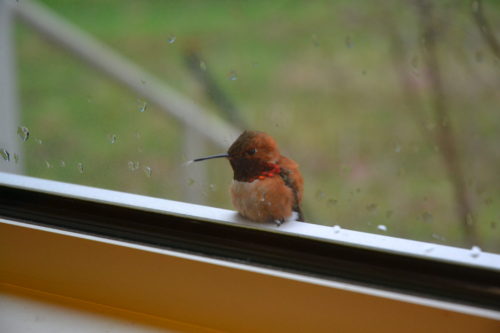
Hummingbirds are excellent accidental pollinators, that carry pollen on their feathers and beaks from long tube shaped flowers while in search of nectar. Photo courtesy of Kay Gallagher
Small bird pollinators like hummingbirds, provide food for reptiles, predatory birds and carnivorous mammals. These roles combined with pollination itself, aid in supporting the health and resiliency of our ecosystems.
Pollinators are an integral part of our ecosystems and our world. Without their presence, earth would be a much different place. Unfortunately, just like many other species on our planet, pollinators face some serious natural and anthropogenic threats. The largest threats include, habitat loss and degradation, pesticide misuse and poisoning, and parasites and disease. With the increase of land development, clear cutting, and pollution, pollinators are running out of healthy places to call home. These factors have political, economic and social origins that are not easily addressed.
Starting at the local level, compassionate citizens can enact change and make a difference by speaking up. Additionally, many insects are resilient, and there are small actions that we can make at home, in our parks, backyards and cities to help pollinators.
To do my part, I decided to create a native pollinator garden at the Blue House Garden in Marblemount.
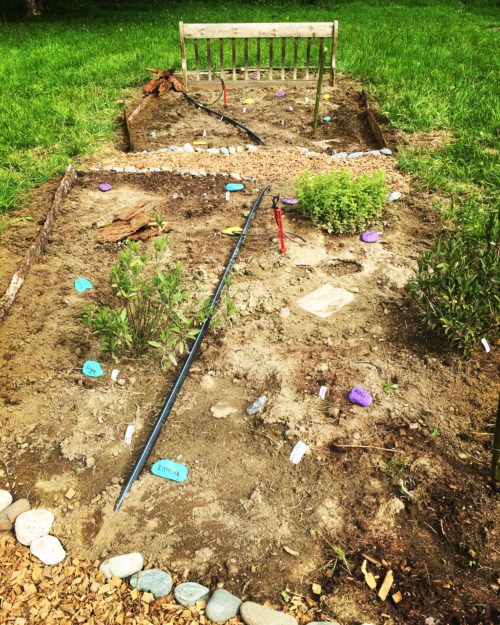
A picture from the stages of making the native pollinator garden in Marblemount, Washington. Photo courtesy of Kay Gallagher
I used several pollinator and native plant specific resources to gather as much information about the habitat and resources that pollinators of the Mixed Cascade Forest Ecosystem require. With a small budget, I gathered many materials from friends or local resources. My intention for the space is to not only attract pollinators to the garden, but to provide them with a place of refuge and food sources. With the addition of education signs and activities that it can serve as a place to educate others of pollinator importance to our ecosystems.
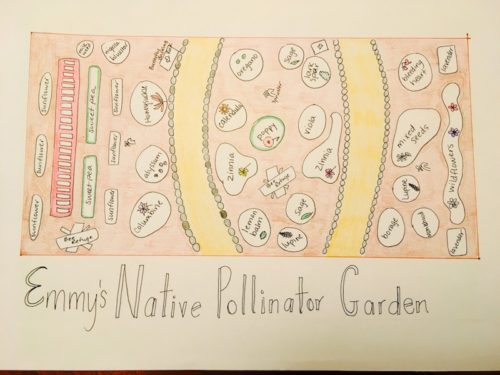
A map of the plants and pollinator resources in the garden space, including bee refuge areas, basking rocks for butterfly and host plants for pollinator larvae. Photo courtesy of Kay Gallagher
If you are wondering what you can do to help combat the ‘plight of the pollinators’ here are a few tips:
- Do your research before you plant flowers in your yard or garden, some wildflower mixes contain invasive or noxious species that can degrade pollinator habitat.
- Act with your wallet. Choose to support local farms that don’t use pesticides or engage in pollinator habitat management practices.
- Plant a small native garden in a window box or on the edge of your garden.
- Leave parts of your lawn un-mowed, bees love tall grass for forage and refuge.
- Become involved in local efforts for plant restoration and creation of green spaces.
- Educate yourself! A few great resources include: The Xerces Society, The Great Pollinator Project, The Pollinator Partnership.

